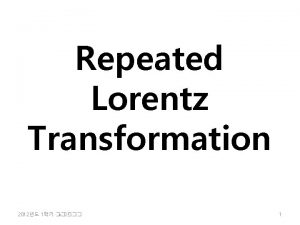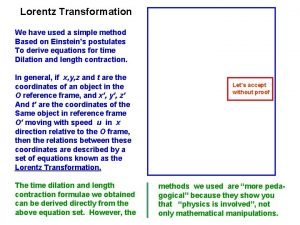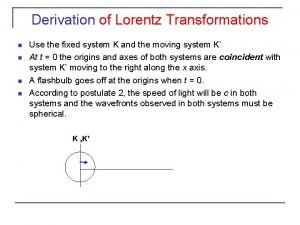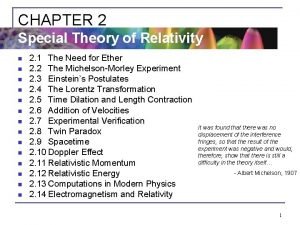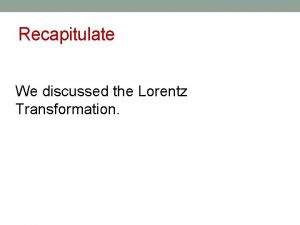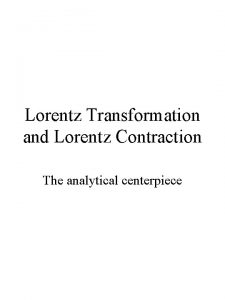Lorentz Transformation We have used a simple method






- Slides: 6

Lorentz Transformation We have used a simple method Based on Einstein’s postulates To derive equations for time Dilation and length contraction. In general, if x, y, z and t are the coordinates of an object in the O reference frame, and x’, y’, z’ And t’ are the coordinates of the Same object in reference frame O’ moving with speed u in x direction relative to the O frame, then the relations between these coordinates are described by a set of equations known as the Lorentz Transformation. The time dilation and length contraction formulae we obtained can be derived directly from the above equation set. However, the Let’s accept without proof methods we used are “more pedagogical” because they show you that “physics is involved”, not only mathematical manipulations.

Lorentz Transformation, continued At the first glance, one may think that the Lorentz Transformation is “pretty asymmetric” – i. e. , one may expect that the equations for an inverse transformation, expressing x, y, z and t in terms of x’, y’, z’ and t’ look somewhat different. Surprisingly, there is only a tiny difference between the two sets! Let’s show that: first, we solve the first equation for x, and the last one for t : Now we insert the first equation into the second one:

Deriving inverse Lorentz Transformation: Now we need to do some more algebra: See? The inverse transformation formula has exactly the same form as the original one for t’ , the only difference being the “+” symbol in the numerator, not “–”, as before. In a similar manner, we can obtain the formula for x – but I will leave that for you, as a homework problem.

Lorentz Transformation, and inverse Lorentz transformation: From O to O’, i. e. , x, y, z, t → x’, y’, z’, t’ From O’ to O , i. e. , x’, y’, z’, t’ → x, y, z, t Question: can you explain why in one there is minus, and plus in the other? Yes, you are right! Because if O’ moves relative to O with speed u, then O moves relative to O’ with speed –u.

Relativistic velocity addition – consider the following situation: Observer O’ He registers: Car speed = v’ Entire frame moving with speed u What speed does Observer O register? According to the Galilean Transformation, u+ v’. But this is no longer true in relativity physics! Observer O

